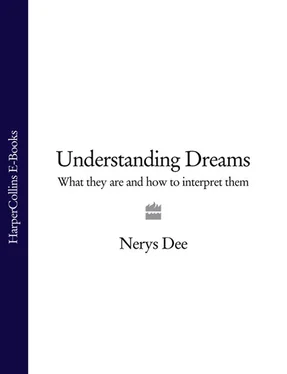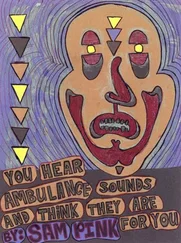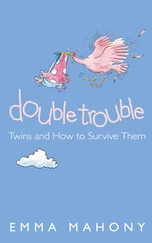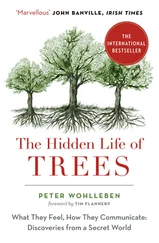UnderstandingDreams
What they are and how to interpret them
Nerys Dee

Copyright Copyright Introduction the dream diary dreams and sleep dreams and things that go bump in the night the power of dreams psychological fefinitions of dreams the language of dreams understanding your dreams the dictionary of signs and symbols About The Publisher
Thorsons
An Imprint of HarperCollins Publishers 1 London Bridge Street London SE1 9GF
www.harpercollins.co.uk
Published by The Aquarian Press 1991
This edition published by Thorsons 2000
© Nerys Dee 1991
Nerys Dee asserts the moral right to be identified as the author of this work.
A catalogue record of this book is available from the British Library
All rights reserved under International and Pan-American Copyright Conventions. By payment of the required fees, you have been granted the nonexclusive, nontransferable right to access and read the text of this ebook on screen. No part of this text may be reproduced, transmitted, downloaded, decompiled, reverse engineered, or stored in or introduced into any information storage and retrieval system, in any form or by any means, whether electronic or mechanical, now known or hereinafter invented, without the express written permission of HarperCollins e-books.
HarperCollins Publishers has made every reasonable effort to ensure that any picture content and written content in this ebook has been included or removed in accordance with the contractual and technological constraints in operation at the time of publication.
Source ISBN: 9781855380868
Ebook Edition © August 2016 ISBN: 9780007388394
Version 2016-08-24
Cover
Title Page Understanding Dreams What they are and how to interpret them Nerys Dee
Copyright Copyright Copyright Introduction the dream diary dreams and sleep dreams and things that go bump in the night the power of dreams psychological fefinitions of dreams the language of dreams understanding your dreams the dictionary of signs and symbols About The Publisher Thorsons An Imprint of HarperCollins Publishers 1 London Bridge Street London SE1 9GF www.harpercollins.co.uk Published by The Aquarian Press 1991 This edition published by Thorsons 2000 © Nerys Dee 1991 Nerys Dee asserts the moral right to be identified as the author of this work. A catalogue record of this book is available from the British Library All rights reserved under International and Pan-American Copyright Conventions. By payment of the required fees, you have been granted the nonexclusive, nontransferable right to access and read the text of this ebook on screen. No part of this text may be reproduced, transmitted, downloaded, decompiled, reverse engineered, or stored in or introduced into any information storage and retrieval system, in any form or by any means, whether electronic or mechanical, now known or hereinafter invented, without the express written permission of HarperCollins e-books. HarperCollins Publishers has made every reasonable effort to ensure that any picture content and written content in this ebook has been included or removed in accordance with the contractual and technological constraints in operation at the time of publication. Source ISBN: 9781855380868 Ebook Edition © August 2016 ISBN: 9780007388394 Version 2016-08-24
Introduction
the dream diary
dreams and sleep
dreams and things that go bump in the night
the power of dreams
psychological fefinitions of dreams
the language of dreams
understanding your dreams
the dictionary of signs and symbols
About The Publisher
When weunderstand our dreams, we begin to understand ourselves. Since we, and we alone, create our dreams for individual, personal reasons, the best, indeed the only, person to unravel the messages they convey is oneself. Throughout the ages there have been many approaches to dreams – mythological, religious, scientific and analytical. These all offer explanations which tend to encourage us to look outside ourselves for meanings and answers, instead of inside, where we single-handedly create our own dreams.
These outer-approaches to dreams and their meanings are invaluable for comparing our dreams with those of others and for discovering traditional and social significances relating to certain objects and symbols we find in them. Dream dictionaries are the ultimate expression of external dream interpretation, but many of the signs and symbols we use are unique and have personal meanings only. These vary, depending on individual experiences, beliefs, inherited cultural traditions and present-day society. An example of this is the sun as a symbol. In western tradition it is a sign of life, energy and renewed hope. Metaphorically, those upon whom ‘the sun shines’ are said to be fortunate in the extreme. If, on the other hand, you live or originate from hotter climates, this same sun may well be seen as a menace and a threat to existence. Similarly, if, as a child, you were badly sunburned in any land, traditional meanings would soon be overshadowed by personal memories of pain and suffering.
We need, therefore, to complement outer interpretation with inner understanding, thus making a blend of intellect and intuition, head and heart. All problems can be looked at in two distinctly different ways – practically or emotionally. Usually, when we are awake and thinking consciously, we view problems and situations from the practical, literal point of view, but when we are asleep and dreaming, these same problems and situations are seen from an intuitive and symbolic standpoint. This is looking at life from the inside, not from the outside. When we can do this, we are able to blend the two together, thus receiving the best of both worlds.
In dreams, inspirations are born, original ideas develop, acceptance is learned and solutions are found. How often have we gone to sleep tormented by a worry, to find on waking, that things are not quite as bad as they were yesterday? This is because we have ‘slept on it’ and allowed our hearts, which remain mostly silent during the day in the presence of our intellect, to speak to us throughout the night.
Understanding what we are saying to ourselves in a dream is very important; once we know they are potential sources of wisdom offering guidance in ways totally different from those found in the waking, outer world, there is no reason why we cannot usefully accept their bounty, as others have done in the past. For example, many inventors have discovered their unique creations through dreaming, just as some composers have first heard their own masterpieces in their sleep. Authors, too, have observed scenes and plots in a dream-state which, when set to words, have proved bestsellers.
The ancients knew all about this inner source and its keeper, and made conscious efforts to contact it. To help themselves in facing life’s problems, they used to ‘incubate a dream’. This simply means requesting the right dream at the right time. To do this they would retire to special temples and request help from the priestesses, priests, goddesses, gods, and sometimes from God Himself. Now, because most people regard their dreams as the incoherent ramblings of a worried mind, they rarely experience important dreams, and when they do, it is more by luck than judgement. Once we accept that dreams are inner sources of help, however, they, or that aspect of ourselves which produces them, respond immediately. Today there are no such temples but this does not mean that the age of creative dreaming belongs to the past. Far from it. Now, we can become our own priest or priestess and call upon our own forces, in our own inner temple.
Читать дальше













